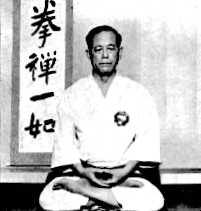Shōshin Nagamine
| Shōshin Nagamine | |
|---|---|
 Shōshin Nagamine, sitting in the lotus position | |
| Born |
15 July 1907 Naha, Okinawa |
| Died |
2 November 1997 (aged 90) Naha, Okinawa |
| Style | Matsubayashi-ryu |
| Teacher(s) | Taro Shimabuku, Ankichi Arakaki, Chotoku Kyan, Motobu Choki |
| Rank | Hanshi, 10th Dan[1] |
| Notable students | Chokei Kishaba, Takayoshi Nagamine, Katsuhiko Shinzato, Ansei Ueshiro, J. Eduardo Castro |
Shōshin Nagamine (長嶺 将真 Nagamine Shōshin, 15 July 1907 – 2 November 1997) was a Japanese author from Okinawa as well as a soldier, police officer, and karate master.
Early Life and Karate-do
Nagamine was born in Tomari, in Naha, Okinawa. He was a small and sickly child, and he contracted a gastroenteric disorder in 1926, his second year of high school. He began a self-imposed diet and took up karate under the watchful eye of his next-door neighbour, Chojin Kuba. Nagamine soon became a picture of good health, crediting his recovery to "hard work both at school and training of Karate". His health improved to such an extent that he became a leader of the school's karate club, and his friends dubbed him Chippaii Matsu, a nickname meaning "tenacious pine tree".
Career in the Army
After graduation in March 1928, he began to study martial arts full-time, moving to Shuri and training under Taro Shimabuku (島袋善良)and Ankichi Arakaki. Later that year, he was conscripted into the Japanese army in the 47th Infantry Division, and fought in China before receiving an honourable discharge in 1931.
Leaving the army, Nagamine sought an area in which his martial arts abilities would be useful, eventually settling on the police force.
Career in the Police force
During his time as a police officer, Nagamine received further instruction in karate from Chotoku Kyan and Motobu Choki, and achieved the title of Renshi in 1940. By 1951, Nagamine was a Police Superintendent, of Motobu, and was training his own officers in karate.
Nagamine retired as a policeman in 1952, and in 1953 he returned to Naha City and set up his own dojo, which he named "Matsubayashi-Ryu Kodokan Karate and Ancient Martial Arts Studies". From the dojo he taught Matsubayashi-ryu, a karate school he had invented in 1947, and named in honour of Sokon Matsumura and Kosaku Matsumora. He continued to teach the discipline until his death in 1997. He was succeeded in 1997 by Kensei Taba who retired to form his own style of Karate in 2002 and [2]then by his son, Takayoshi Nagamine,who was the head (sōke) of Matsubayashi-ryu until his own death in 2012.
Author
Nagamine wrote two books in Japanese, The Essence of Okinawan Karate-Do and Tales of Okinawa's Great Masters. The Essence of Okinawan Karate-Do, which has been reprinted many times, was first published in the English language in 1976. This was translated into the English language by Nagamine's student Katsuhiko Shinzato. Tales of Okinawa's Great Masters received its first English translation in 2000; this was translated into the English language by Patrick McCarthy [Bubishi].
References
- ↑ Okinawan Karate, Second Edition, by Mark Bishop, Tuttle Publishing, p. 167, ISBN 0-8048-3205-6
- ↑ http://www.shogen-ryu.org/uploads/2/7/0/3/2703747/taba_sensei_bio.pdf
Sources
- Autobiographical article, written in 1992. Accessed 2005-09-23.
- The Founder of our Style, Nagamine Shoshin Sensei. Accessed 2005-09-23.
- History of the Matsubayashi-Ryu School Accessed 2005-09-23.
Further reading
- Nagamine, Shoshin, The Essence of Okinawan Karate-Do (Hardcover reissue) (1991), ISBN 0-8048-1163-6
- Nagamine, Shoshin, The Essence of Okinawan Karate-Do (Paperback edition) (1998), ISBN 0-8048-2110-0
- Nagamine, Shoshin, Tales of Okinawa's Great Masters (2000), ISBN 0-8048-2089-9
External links
- Shoshin Nagamine's books on sale at alibris.com
- Okinawan Karate and World Peace
- The Hawaii Karate Seinenkai Salutes: Shoshin Nagamine
- Techniques of the Masters: Shoshin Nagamine
- Akari-ki Karate: Nagamine